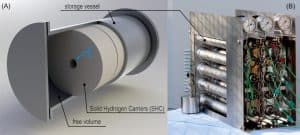The Metal Hydride Center of Excellence at Fraunhofer Institute for Manufacturing Technology and Advanced Materials – IFAM is developing composites that offer considerable advantages over conventional powder- or granule-based metal hydride storage.
Heat management and sensors to determine the state of charge allow these new systems to respond quickly during rapid uptake-discharge cycles that take only a few minutes.
Implementing an energy cycle that uses hydrogen requires a variety of storage and distribution technologies. As solid hydrogen carriers, also known as SHCs, metal hydrides are a commercially viable alternative to compressed or liquid hydrogen if the aim is to safely store gas of the highest purity (7.0), at low pressures (2 bars to 40 bars), in a small space (up to 0.15 kgH2/dm³; compared to 0.04 kgH2/dm³ for hydrogen below 700 bars) and without boil-off losses (see Fig. 1) [GUP16].
SHCs take up hydrogen by forming a chemical bond with a solid-state carrier material. In the event of a leak, the gas will not be released into the atmosphere all at once but in small amounts over time. This ensures a high level of system safety.
In the past few years, multiple industries have begun using hydrogen stored in metal hydrides to run submarines, stationary power devices and portable electronics, among other things. Hydrides are also part of vibration-free thermochemical hydrogen compressors, thermochemical heat pumps, and systems for separating H2 and D2, that is, deuterium, isotopes. In addition, they can serve as reversible getters, selectively removing hydrogen from a gas mixture.
…
read more in H2-international May 2020
Authors:
Felix Heubner, Dr. Thomas Weißgärber, Dr. Lars Röntzsch
All for Fraunhofer-Institut für Fertigungstechnik und Angewandte Materialforschung IFAM, Dresden


























0 Comments